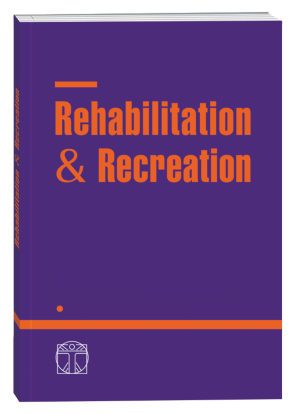PHYSICAL ACTIVITY IN THE TIME OF THE COVID-19 PANDEMIC AND HOME ISOLATION
DOI:
https://doi.org/10.32782/2522-1795.2022.13.17Keywords:
physical culture, physical activity, physical fitness, virus.Abstract
The appearance of the SARS-CoV-2 coronavirus in 2019 and the rapid spread of the coronavirus, has become the reason for WHO to announce many restrictions related to the movement of the population, accumulation and use of sports and recreational infrastructure. Most schools and colleges have switched to a hybrid or fully remote learning mode. Limited access to sports facilities, along with home isolation, which additionally adversely affects the mental state of people, as well as motivation to work and study, caused a change in some elements of lifestyle. The coronavirus (COVID-19) pandemic can pose a challenge to maintaining an active lifestyle. The COVID-19 coronavirus is spread by airborne droplets, i.e. when coughing or sneezing, it spreads from a sick person to a healthy person through the mouth, nose and eyes. Lack of exercise and physical activity is a factor that increases the risk of acute COVID-19 and death as a result of coronavirus infection, according to the results of studies involving nearly 50,000 people who contracted the SARS-CoV-2 virus. Experts emphasize that not only how much and how we eat, but also how much we move is the key to health. The basis of the "Pyramid of healthy nutrition and lifestyle" is currently physical activity. For good condition and health, WHO recommends at least 150 minutes of moderate-intensity physical activity or 75 minutes of vigorous vigorous activity per week, or a combination of both. This level can also be achieved at home, without special equipment and with limited space. Daily activity has a number of health benefits, including improves the condition, lowers the level of blood pressure and helps to maintain cholesterol and triglycerides at the correct level. It also helps to improve well-being, reduce stress and release more energy. Together with a varied, properly balanced diet, it allows you to prevent the development of overweight and obesity, which is very dangerous for our health. The WHO points out several ways to stay active and reduce sedentary living at home during quarantine. If we are at home, be as active as possible – exercise, dance, climb stairs, active housework is also a good dose of exercise.
References
Czarnecki D., Skalski D., Grygus I. (2022). Free time of elderly people in terms of physical activity. Quality in Sport. 8(4):33-38. http:// dx.doi.org/10.12775/QS.2022.08.04.003
Czarnecki D., Skalski D.W., Kowalski D., Vynogradskyi B., Grygus I. (2022). Aktywność fizyczna seniorów warunkiem zdrowia i dobrej jakości życia. Rehabilitation & recreation. 12:105-112. DOI https://doi.org/10.32782/2522- 1795.2022.12.15
Grygus I., Nesterchuk N., Skalski D., Zabolotna O. (2021). Edukacja w polskim społeczeństwie nowoczesnym a edukacja zdrowotna. Kultura fizyczna, edukacja zdrowotna i bezpieczeństwo. Gdańsk, 81-97.
Karpukhina Y., Vasylieva N., Grygus I., Muszkieta R., Zukow W. (2020). Study of quality of life and effectiveness of physical therapy of women after mastectomy in the COVID-19 pandemic conditions. Balneo Research Journal. 11(3):315-322 DOI 10.12680/balneo.2020.359
Kłossowski M. (1999). Przegląd i charakterystyka metod oceny poziomu aktywności fizycznej oraz jej wpływu na organizm człowieka. Aktywność fizyczna. Akademia Wychowania Fizycznego im. Józefa Piłsudskiego w Warszawie.
Kozdroń E. (2008). Rekreacja ruchowa jako składnik zdrowego stylu życia. Minimum aktywności ruchowej. Podstawy teorii i metodyki rekreacji ruchowej. Podręcznik dla instruktora rekreacji ruchowej [red. E. Kozdroń]. Towarzystwo Krzewienia Kultury Fizycznej, Warszawa.
Maltsev D., Andrieieva O., Kashuba V., Yarmak O., Dobrodub E., Grygus I., Prusik K. (2022). Assessment of the Quality of Active Family Leisure. Physical Education Theory and Methodology. 22(3):386-392. https://doi.org/10.17309/tmfv.2022.3.13
Mucha B., Mucha M. (2021). Aktywność fizyczna w dobie pandemii COVID-19. Wrocław.
Nowakowska E., Sulimiera- Michalak S. (2020). COVID-19 – Choroba wywołana zakażeniem wirusem SARS-CoV-2 globalnym zagrożeniem dla zdrowia publicznego. Postępy Mikrobiologii – Advancements of mMcrobiology.
Psaltopoulou T., Kyrozis A., Stathopoulos P. i wsp. (2008). Diet, physical activity and cognitive impairment among elders: the EPIC-Greece cohort (European Prospective Investigation into Cancer and Nutrition). Public Health Nutr.
Skalski D., Kowalski D., Kindzer B., Grygus I. (2021). Wybrane aspekty w edukacji zdrowotnej w realizacji zabaw rekreacyjnych w okresie pandemii. Rehabilitation & recreation. 9:109-119.
Skalski D., Zabolotna O., Grygus I. (2020). Jazda na rowerze a aspekty zdrowotne i społeczne w okresie pandemii. Pozytywne aspekty aktywności fizycznej i sportu – perspektywa społeczna. Monografia pod redakcją Dariusza W. Skalskiego i Piotra Godlewskiego. 223-238.
Skalski D.W., Grygus I., Skalska E., Rybak L. (2022). Współczesna kultura fizyczna a styl życia. Spektrum peregrynacji po kulturze fizycznej dla mistrzów wychowania fizycznego praca zbiorowa pod redakcją Marcina Białasa i Dariusza W. Skalskiego. Gdańsk. 21-33. ISBN 978-83-66894-06-8
Skalski D.W., Kowalski D., Grygus I., Nesterchuk N. (2020). Physical culture in a rural environment and health education. Rehabilitation & recreation. 6:76-88. http://doi.org/10.5281/ zenodo.4033295
Wolańska T. (1971). Rekreacja fizyczna. Centralny Ośrodek Metodyki Upowszechniania Kultury, Warszawa.
Wolańska T. (1995). Aktywność fizyczna a zdrowie. Biblioteka Polskiego Towarzystwa Naukowego Kultury Fizycznej. Tom III, Warszawa.
Wolny B. (2006). Wychowanie fizyczne w zreformowanej szkole, Lublin.
Zabolotna O., Skalski D., Nesterchuk N., Grygus I. (2019). Health-related good of physical culture and health education. Rehabilitation & recreation. 5:53-58.
Zahorska-Markiewicz B. Porady eksperta. http://www.odchudzanie.org.pl.arty
Zdrowy styl życia. Aktywność fizyczna, http://www.3lo.lublin.pl/biologia/aktywnosc. html
Downloads
Published
How to Cite
Issue
Section
License

This work is licensed under a Creative Commons Attribution-NonCommercial-NoDerivatives 4.0 International License.











